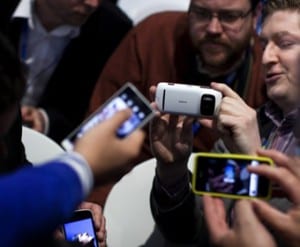MWC: Carriers Joyn forces
MWC 2012 in Barcelona was the venue for the Group of 5’s (G5) response to the OTT threat with the launch of RCS-5. Though Vodafone’s stand nearly collapsed under the weight of anticipation – and had to be evacuated – the new brand ‘Joyn’ and OEM relationships largely confirmed expectations of the carriers’ commitment to take on the OTT players.
February 27, 2012

By Sheridan Nye
 MWC 2012 in Barcelona was the venue for the Group of 5’s (G5) response to the OTT threat with the launch of RCS-5. Though Vodafone’s stand nearly collapsed under the weight of anticipation – and had to be evacuated – the new brand ‘Joyn’ and OEM relationships largely confirmed expectations of the carriers’ commitment to take on the OTT players.
MWC 2012 in Barcelona was the venue for the Group of 5’s (G5) response to the OTT threat with the launch of RCS-5. Though Vodafone’s stand nearly collapsed under the weight of anticipation – and had to be evacuated – the new brand ‘Joyn’ and OEM relationships largely confirmed expectations of the carriers’ commitment to take on the OTT players.
Spanish subsidiaries of Telefonica, Vodafone and Orange plus Deutsche Telekom and Telecom Italia joined forces to leverage their combined market strengths. “The only legitimate advantage we have is reach,” said Kobus Smit, in charge o f next generation communicaitons, voice & messaging, for Deutsche Telekom. A Telefonica representative commented that RCS would “replace SMS”.
The group also announced the OEMs that will offer RCSe-enabled devices, accredited for the carriers’ networks. Sony, Samsung, LG, Nokia, Motorola, HTC, Huawei and ZTE will brand their devices with the Joyn ‘mark’ to indicate compliance. More surprisingly, RIM will also produce Joyn devices, suggesting the company is hedging its bets in the messaging market.
RCS-5 is a converged specification of previous releases, including RCSe, for compatibility in the US as well as Europe. Vodafone Spain has already launched live service along with an Android app. Full commercial launch of Joyn is scheduled for September, initially in Spain. Pricing will be set on a country-by-country basis.
Mobile industry befriends Facebook
Facebook and mobile operators became best friends at Mobile World Congress today, as the social network giant pledged to help do away with fragmented mobile browser standards and to help operators bill for purchases made through Internet applications. The move places Facebook at the heart of the mobile community, with the Internet giant acting as a champion for a mobile internet that works better for mobile operators and their customers, and one that operators can monetize more effectively than they do at present.
Nokia underwhelms
In devices news, Nokia launched two new smartphones that strengthened its Microsoft Windows Phone 7 (WP7) offer. The Lumia 610 and Lumia 900 (non-LTE version) are targeted at the non-US market. Notably, the Lumia 610 has the lowest BOM and is the lowest cost WP7 phone introduced so far, retailing for about 190 Euros. Otherwise, the vendor’s impact at the show is somewhat low-key.
Mobile payments
Visa launched its Visa Mobile Prepaid, which enables existing mobile-money wallets to use the Visa network infrastructure, such as ATMs, online payments, card machines.
In a bid to enable interoperability between mobile money networks, Visa proposes to use its robust settlements system to manage cash-in and cash-out transactions between mobile operators. However, some emerging market operators are unlikely to embrace interoperability. This is especially so in Africa where operators rely on their own services to reduce churn, though most have yet to profit from mobile money.
Vodafone’s decision to launch a prepaid-credit-card enabled m-wallet (in partnership with Visa) follows a trend among mobile operators that want to offer e-commerce and point-of-sale payments on phones. Orange and Telefonica-O2 have also launched similar prepaid wallets, as a first step in their NFC payment rollout plans.
Read more about:
DiscussionYou May Also Like








.png?width=300&auto=webp&quality=80&disable=upscale)


_1.jpg?width=300&auto=webp&quality=80&disable=upscale)